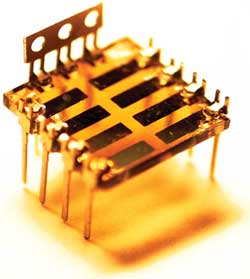The devices harvest blue as well as red light to reap more energy than ever before.
“By demonstrating this new strategy for beating the usual solar-cell efficiency limits, we’ve raised the target for everyone to aim at.” – Professor Neil Greenham, University of Cambridge
A novel solar cell design could harvest energy from the sun much more efficiently than traditional devices do, dramatically improving the amount of useful energy solar panels can create.
Traditional solar cells capture only certain wavelengths from the sun, which means that much of the absorbed light’s energy is lost as heat – particularly the energy from the photons in the blue range. And that means that traditional solar cells cannot convert more than 34 percent of available sunlight into electricity.
The work was done by a team in the department of physics at the University of Cambridge in the UK, led by professor Neil Greenham and professor Sir Richard Friend.

A new solar cell developed by researchers at the University of Cambridge in the UK is more efficient than traditional cells because it harnesses more than just red light. Courtesy of Bruno Ehrler and Neil Greenham, University of Cambridge.
The new hybrid cell absorbs red as well as blue light to boost the electrical current. A typical solar cell generates a single electron for each photon captured. But by adding the organic semiconductor pentacene, the solar cells can generate two electrons for every photon from the blue light spectrum. This could enable the cells to capture 44 percent of the incoming solar energy.
“Pentacene is special, since absorbing one photon rapidly produces two charge-pairs rather than the usual one,” Greenham said. “There aren’t many other organic materials out there at the moment that do this, but maybe we could design more now that we understand the physics.”
The researchers do not yet plan to reach out and harness additional wavelengths. “It makes sense to stick with just two materials in the device,” Greenham said. “The lead selenide absorbs the red and infrared light, and the pentacene efficiently captures the energy of the green and blue light.
“To do even better than this in a single device, we’d need a material that generates three pairs of charges for each photon absorbed, but this would be hard to do and wouldn’t give a big increase in efficiency.”
The paper, “Singlet Exciton Fission-Sensitized Infrared Quantum Dot Solar Cells,” was published in Nano Letters (doi: 10.1021/nl204297u).
It’s a good start, the researchers said, but there is more to be done. “The work we published shows that this new effect works, but the actual efficiencies we achieve still aren’t great,” Greenham said. “We’re working hard to push the efficiencies up, but there’s a lot of work still to do before we have devices that can be deployed in real applications.
At the same time, lots of companies are developing low-cost printed photovoltaics for different markets. By demonstrating this new strategy for beating the usual solar-cell efficiency limits, we’ve raised the target for everyone to aim at.”
But solar cell efficiency itself isn’t the only factor in cost-effectiveness. “Organic and hybrid solar cells have an advantage over current silicon-based technology because they can be produced in large quantities at low cost by roll-to-roll printing,” said Bruno Ehrler, lead author on the paper. “However, much of the cost of a solar power plant is in the land, labor and installation hardware. As a result, even if organic solar panels are less expensive, we need to improve their efficiency to make them competitive.
“Otherwise, it’d be like buying a cheap painting, only to find out you need an expensive frame.”